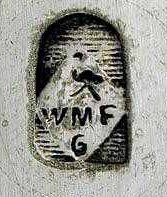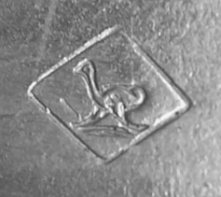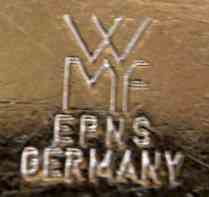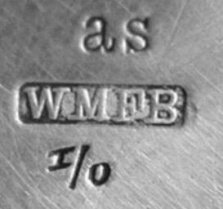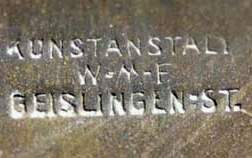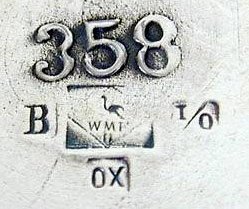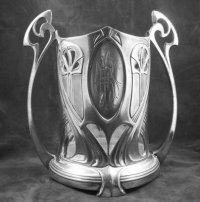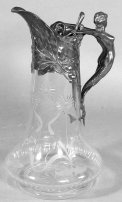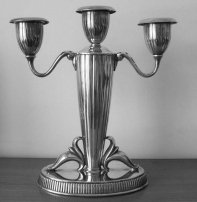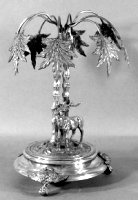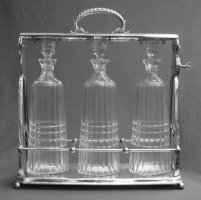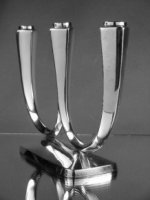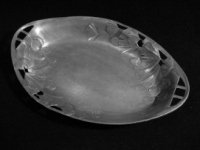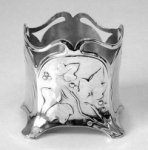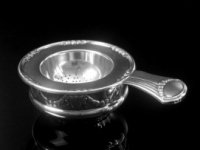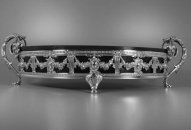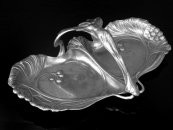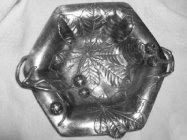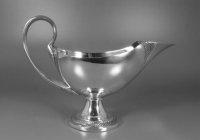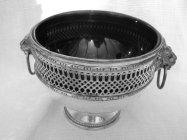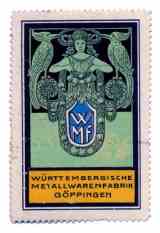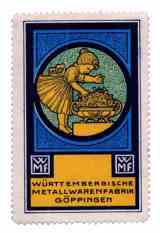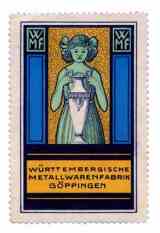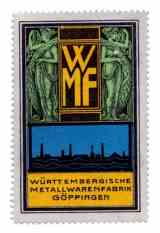WMF
WURTTEMBERGISCHE METALLWARENFABRIK
MARKS - HALLMARKS - HISTORY
|
This is a page of A Small
Collection of Antique Silver and Objects of vertu, a 1000
pages richly illustrated website offering all you need to know
about antique silver, sterling silver, silverplate, sheffield
plate, electroplate silver, silverware, flatware, tea services
and tea complements, marks and hallmarks, silver marking system and silver
hallmarks guide, articles, books,
auction catalogs, famous silversmiths (Tiffany, Gorham, Jensen,
Elkington, WMF, Reed & Barton, Mappin & Webb, Bateman Family),
history, oddities ...
SITE MAP -
HOME PAGE
click on +1 button of google if you like silvercollection.it
|
WMF MARKS
WMF - Supplementary marks for hollow-ware
A = reject item
AA = refuse
as = antique silver finish
B = Britannia-metal
bg = gilt base
brass = export mark
copper = export mark
D.R.P. Deutsches Reichspatent (Imperial German Patent)
ep = electro-plated
gg = entirely gilt
|
go = parcel-gilt
ig = gilt interior
I/O = Normal thickness of gilding or silver-plating
M = brass
MB = partly brass, partly Britannia metal
N NS = nickel-silver
O silver-plate deposit, 50% thicker than the normal coating
OX = oxidized
zg = fancy gilt
* = export ware or special production (possibly)
|
further WMF marks and information:
Hollow ware and trays
Cutlery and Napkin Rings
WMF - WURTTEMBERGISCHE METALLWARENFABRIK: HISTORY
In 1853, Daniel Straub, a miller from Geislingen, joined forces with the Schweizer Brothers to form the
"Metallwarenfabrik Straub & Schweizer" in Geislingen. This was the second company to be
founded by Straub - previously in 1850, from the nucleus of a small repair workshop, which he had set up
to work on the construction of Geislingen's famous railway incline, he had founded the Maschinenfabrik
Geislingen. This company was involved mainly in manufacturing mill turbines and traded throughout Europe.
As early as 1862, the young company distinguished itself by winning a gold medal at the World Exhibition in
London. In 1866, following the departure of the brothers Louis and Friedrich Schweizer, the company was
renamed Straub & Sohn" (Straub & Son). The company showroom, built in 1868 in Berlin, gradually
evolved to become the company's first retail outlet. Three years later, the company was already employing
60 workers. By 1880, the number of employees had grown to approximately 200 and the company was already
producing 960 different items.
1880 saw the merger between Straub & Sohn and "Ritter & Co.", Esslingen, to form a public
limited company under the name of Wurttembergische Metallwarenfabrik. At the time of the merger, Ritter &
Co.'s Esslingen factory was already using the electroplating method of silver plating and had the more
modern production facilities at its disposal. Straub's company, on the other hand, was the more profitable
of the two.
1892 saw the development of a special technique for silver plating cutlery, whereby the silver is
distributed in a way that, at the points of the cutlery most exposed to wear and tear, the coating is twice
as thick as elsewhere. This process was patented and is still in use today. Known nowadays as 'Perfect
Hard Silver plating' the technique remains exclusive to WMF.
Under Carl Hugele the company gained international standing. At the turn of the century the factory in
Geislingen employed 3,000 workers. By 1910, this number had already grown to 4,000, making WMF the largest
company in Wurttemberg at this time. Sales catalogues were printed in twelve languages. Subsidiary
companies in London, Warsaw and Vienna opened up export markets.
Under the direction of Albert Mayer the WMF studio was influenced by the art nouveau style. The product
range was modernized and considerably extended. In 1905 WMF acquired a majority holding of the Cologne
company Orivit AG, which manufactured products from "Orivit", a tin alloy.
As of 1925, products created by the Contemporary Decorative Products Department (NKA) made their debut on
the market. This department was set up under the direction of Hugo Debach in order to establish the name
of WMF amongst consumers interested in art and design. This department was responsible for producing the
special "Ikora" finish, which has earned an important place in the annals of art history. The
"Ikora" brand name referred to a specific method of treating the surface of the metal, by which
layers of coating were applied in a partly chemical and partly heat induced process. A host of newly
developed hand-finishing techniques enhanced the possibilities for adding decorative flourishes to the
products. Despite being mass produced, every item looked as if it had been individually crafted.
At the end of the war the company had lost its foreign assets, associated factories and retail outlets.
The years following 1945 saw the start of a concerted effort to reconstruct in terms of personnel,
organizational structures and technology in the remaining factory sites. The network of retail shops was
rebuilt. Very soon, subsidiaries sprang up in the USA, Holland, Canada, Switzerland, Austria and Italy.
By 1950, WMF staff numbers had again swelled to 3,000. Silverplated tableware and cutlery accounted for
two thirds of WMF's turnover, with shops specialising in clocks and watches, gold and silverware
representing the company's main customers. A shift in emphasis occurred at the end of the 1950s and was
marked by an increase in the importance of Cromargan cutlery and hollowware. This period saw the creation
of classic products, such as designed by Wilhelm Wagenfeld, which still feature in or have been reintroduced
into the WMF collection. It also saw an increase in the volume of trade in household and kitchenware items
between WMF and specialist retail shops. A number of stemware collections completed the WMF catalogue,
followed by the development of an extensive range of products for the hotel and catering industry.
By 1960, the Geislingen factory alone employed around 5,800 workers. A shortage of space and manpower at
this site led to the setting up of additional branch factories, like the factory in Hayingen and Riedlingen.
ORIVIT
1894-1905
The ORIVIT – AG was founded in 1894 as “Rheinische Broncegieserei fur Kleinplastiken ” in Koln-Ehrenfeld by
Wilhelm Ferdinand Hubert Schmitz ( 1863-1939 )
From 1896 they began with the making of luxury items the so called ORIVIT metal (89,85% pewter 7,9 %
antimony 1,9 % copper 0,12 % silver )
In 1900 the factory changed its name to "ORIVIT –AG fur Kunsthandwerkliche Metalwarenfabrikation".
In 1901/02 they built a new factory in Köln- Braunfels and began with a revolutionary new press "the
Huber –Presverfahren" The factory has won several prizes: in Paris the gold medal at the world
exhibition of 1900 in Dusseldorf in 1902 at the "Industrial Design Exhibition" and at the
exhibition in St Louis (USA) 1904 they won 2 Grand Prix prizes and 1 gold medal.
In 1905 the total financial collapse was a fact and the "Wurttembergische Metalwaren Fabrik" (WMF)
bought ORIVIT . They produced items with the name ORIVIT until 1914.
In 1906 the designs from the "Metalwarenfabrik ORION" became ORIVIT. The founder Georg Friedrich
Schmitt (1856-1925 ) of ORION became the director in Köln.
The designers of ORIVIT were:
Hermann Gradl (1883-1964), Georg Grasegger, Walter Scherf (1875- 1909), Vicor Heinrich Seifert, Johann
Cristian Kroner (1838-1911), Georges Charles Couldray
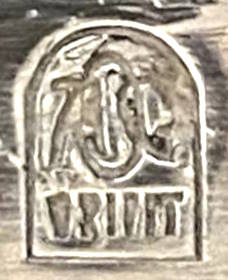 |
IKORA
Is a production line of WMF realized in 1927 by its NKA - Neue Kunstgewerbliche Abteilung (New Art-Commercial
Department) under the direction of Hugo Debach, collector and passionate of Asian Art.
WMF realized under the mark Ikora Edelmetall a wide production of items in geometric style inspired to Art
Decň and to Japanese Art in brass and nickel hand-decorated with enamel applied by fusion to the surface
of the metal.
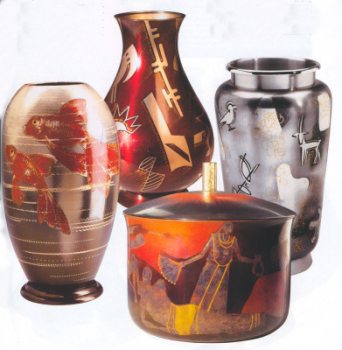 |
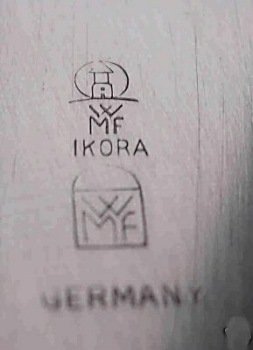 |
Ikora vases, left to right:
silver on brass, 1936 - brass and nickel, 1929, - silver on brass,
decoration by Karl Scheifflele, c. 1949 - copper on brass c. 1928, design by Karl Holzinger,
decoration by Richard Riemerschmid |
| SILVER MANUFACTURERS: MARKS, HISTORY AND INFORMATION |

www.silvercollection.it |
This is a page of 'The What is? Silver Dictionary' of A Small Collection of
Antique Silver and Objects of vertu, a 1500 pages richly illustrated website offering all you need to know about
antique silver, sterling silver, silverplate, Sheffield plate, electroplate silver,
silverware, flatware, tea services and tea complements, marks and hallmarks, articles,
books, auction catalogs, famous silversmiths (Tiffany, Gorham, Jensen, Elkington),
history, oddities ...
HOME - SITE MAP - SILVER DICTIONARY - COOKIES CONSENT AND PRIVACY |
This page was useful? leave your LIKE on
facebook
|
- work in progress on this page - your help, corrections and suggestions will be greatly appreciated -
|

